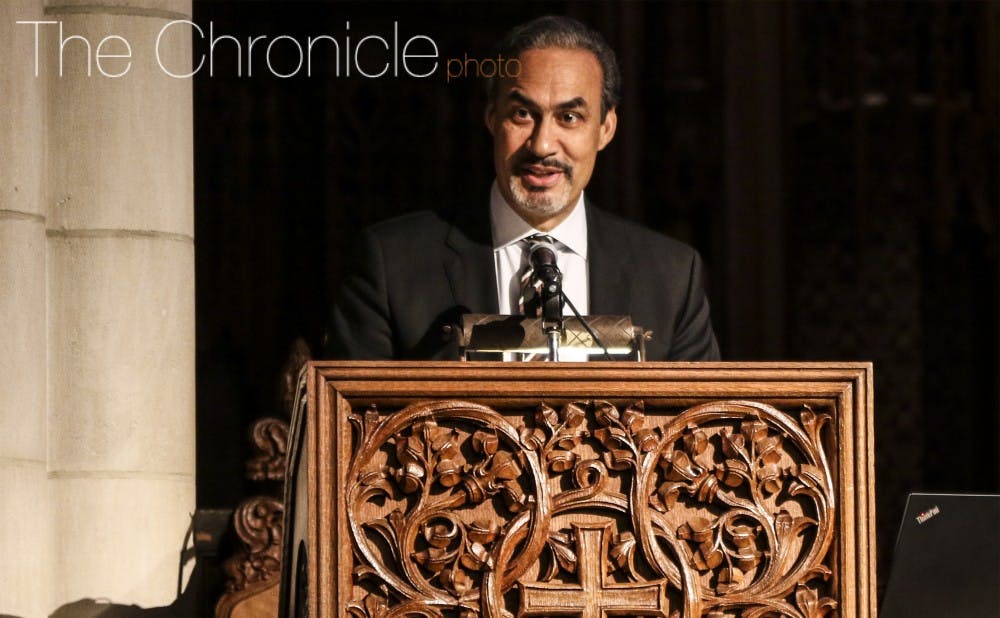When Martin Luther King, Jr. visited Duke in 1964, he was asked to speak at Page Auditorium. On Sunday, hundreds gathered instead inside the Duke Chapel to hear Phil Freelon, architect of the Smithsonian National Museum of African American History and Culture, commemorate King’s legacy.
Freelon, who called Durham his “adopted hometown," has designed a variety of well-known buildings such as the National Center for Civil and Human Rights in Atlanta and local public spaces including the Durham Station Transportation Center. At the event, he shared the concepts behind some of his most famous designs and noted that Julian Abele, who designed the Chapel and much of Duke's original campus, has been a source of inspiration for him.
“This is just an incredible experience to come full-circle—the architecture, Dr. King and the meaning of Duke recognizing Abele this year in a very powerful way,” Freelon told The Chronicle after the service.
Freelon said that this time in the United States' history is not all that different from the era that bred the Civil Rights Movement—noting that it is one of “uncertainty and fear, but also optimism and opportunity.”
He called the Civil Rights Movement a “force for change” and noted King’s “indelible” mark on history.
“As we commemorate him and celebrate this national holiday, each of us must find our own way to keep Dr. King’s dream alive and help move this nation toward his ideal vision for America,” Freelon said.
The architect shared the inspiration for and meanings behind two of his most famous designs—the National Center for Civil and Human Rights and the NMAAHC—and how he incorporated strong ideas into functional spaces.
The iconic image of King and other civil rights leaders at the 1963 March on Washington interlocking arms inspired the shape of the Center for Civil and Human Rights, the architect explained, adding that the various shades of brown panels that encase the outside subtly symbolize the variety of the human race.
As Freelon switched to a presentation slide of the NMAAHC, the crowd erupted in spirited applause before he could say a word on the most recent addition to the National Mall.
He noted that he wanted the museum to be "intentionally unique," a celebration of African-American history and culture.
“Yes, there are difficult stories—segregation, slavery—and those are told. We must tell the truth,” he said. “But we do not want this to be about victims and perpetrators.”
Freelon highlighted some of the unique features of the building and explained their origins.
For instance, the building's main door is designed like a porch to make it more open and welcoming. The structure of the museum, which is so close to the Washington Monument that the obelisk’s shadow nearly touches the building’s exterior, features three bronze tiers, inspired by ironwork in southern cities like New Orleans and Charleston.
Freelon closed his speech by recognizing Abele. Other speakers included Durham Mayor Bill Bell, President Richard Brodhead and Richard Powell, the John Spencer Bassett professor of art and art history at Duke.
Senior Tiana Horn, president of the Black Student Alliance who also spoke at the ceremony, noted the importance of architecture and art and pointed out that the event's location in the Chapel was particularly significant considering King's history at Duke.
“Martin Luther King Jr. was arrested on occasion for going against laws that tried to uphold segregation, and even when he came to speak at Duke, he was asked to speak in Page Auditorium rather than in the Duke Chapel,” she said.
The service ended with the crowd singing “We Shall Overcome," the words of the famous civil rights anthem echoing off the stained glass windows and stone walls of the Chapel.
Get The Chronicle straight to your inbox
Signup for our weekly newsletter. Cancel at any time.
Bre is a senior political science major from South Carolina, and she is the current video editor, special projects editor and recruitment chair for The Chronicle. She is also an associate photography editor and an investigations editor. Previously, she was the editor-in-chief and local and national news department head.
Twitter: @brebradham
Email: breanna.bradham@duke.edu

